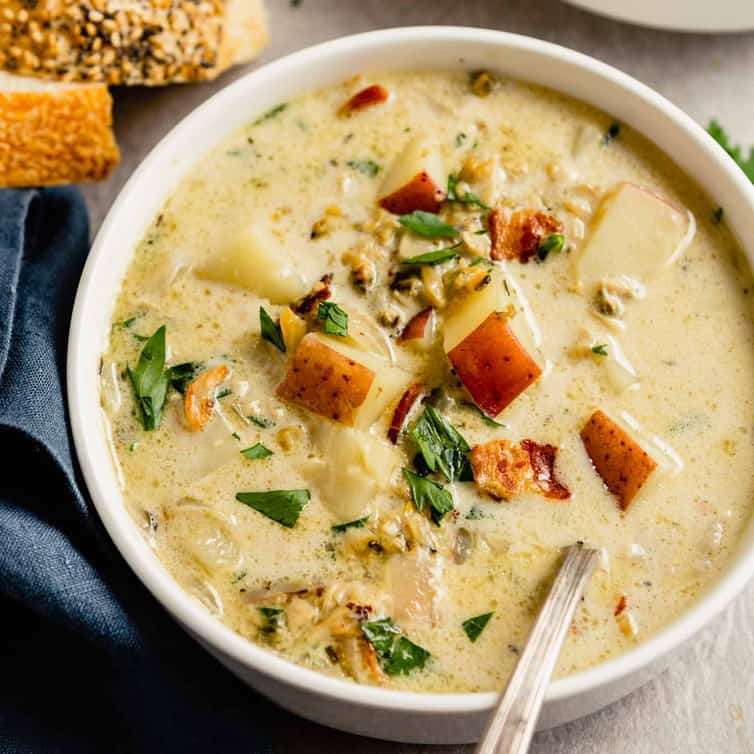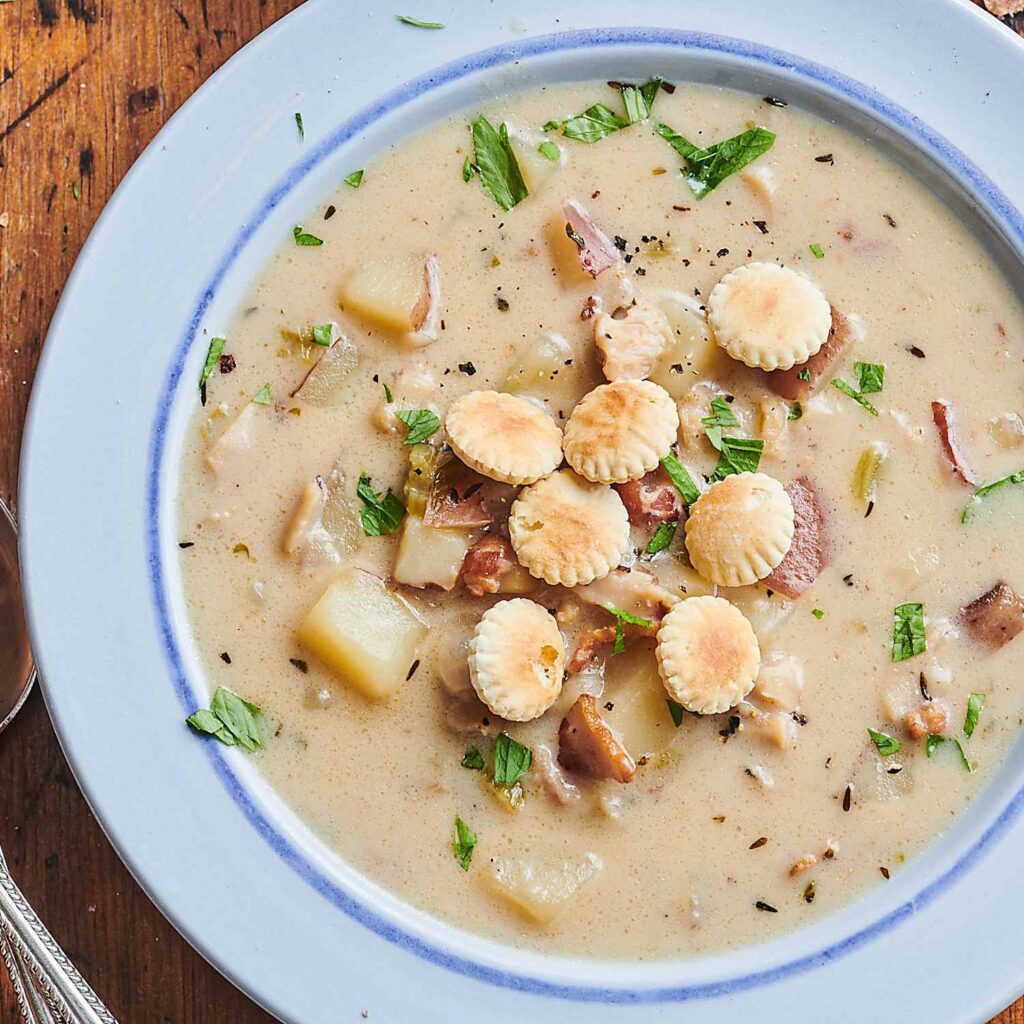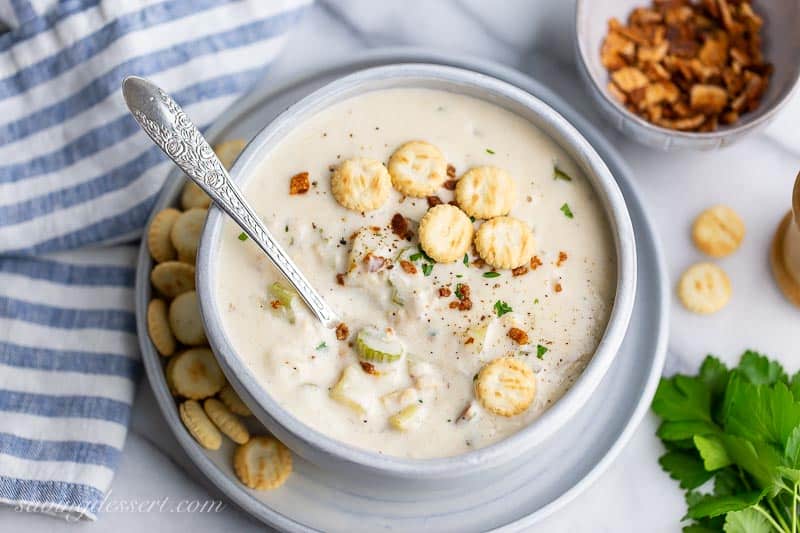Imagine a chilly autumn evening in coastal Maine, where the salty sea breeze whispers promises of comfort and warmth. In your hands, a steaming bowl of New England Clam Chowder—creamy, hearty, and brimming with the ocean’s bounty. This isn’t just soup; it’s a symphony of flavors that transports you straight to the rugged shores of New England. If you’ve ever craved that perfect blend of tender clams, velvety potatoes, and a whisper of smokiness from bacon, you’re in the right place.
In this comprehensive guide, we’ll dive deep into the soul-stirring world of New England Clam Chowder. From its humble origins rooted in indigenous traditions to foolproof recipes that will make your kitchen smell like a seaside shack, we’ve got it all. Whether you’re a seasoned home chef hunting for authentic techniques or a chowder novice ready to impress, this article is your treasure map to culinary bliss. We’ll uncover power-packed tips, avoid common pitfalls, and even pair it with wines that elevate every spoonful.
Ready to unlock the secrets of this iconic dish? Let’s embark on a flavorful journey that will leave you hungry for more. (And don’t forget to check out our internal link to related seafood recipes for even more ocean-inspired delights.)
The Fascinating History of New England Clam Chowder: From Indigenous Roots to National Treasure
New England Clam Chowder isn’t just a dish—it’s a living legacy, woven into the fabric of American culinary heritage. Picture this: long before colonial ships dotted the horizon, indigenous tribes along the northeastern coast were simmering pots of seafood stews over open fires. These early versions, often called “mishickquatash,” combined clams with corn, beans, and local greens, creating a nourishing broth that sustained communities through harsh winters.Clam Chowder This foundational recipe, born from necessity and the land’s abundance, laid the groundwork for what we now cherish as New England Clam Chowder.
Fast-forward to the 18th century, when European settlers—French, English, and Nova Scotian immigrants—arrived with their own chowder traditions. They adapted the indigenous methods, incorporating salt pork for that irresistible smoky depth and potatoes for heartiness. By the 1700s, clam chowder had become a staple in fishing villages from Cape Cod to Portland, Maine. Sailors on long voyages relied on it as a preserved meal, packing it in barrels to fend off scurvy and hunger. One legendary tale recounts how, during the Revolutionary War, chowder fueled patriots at clambakes, turning simple gatherings into symbols of resilience and community.
The 19th century brought refinement. As canning technology advanced, clams became more accessible, spreading the dish beyond New England’s shores. By 1836, the first printed recipe appeared in a Boston cookbook, cementing its place in American lore. Yet, controversy simmered—Manhattan Clam Chowder, with its tomato base, sparked heated debates in the 1930s, leading to tongue-in-cheek laws in Rhode Island banning tomatoes in “true” chowder. Today, New England Clam Chowder stands as a testament to evolution: creamy, unadulterated, and fiercely protected by purists.

But why does it endure? Beyond its comforting embrace, chowder embodies New England’s spirit—rugged, resourceful, and profoundly satisfying. Dive deeper into our internal history series to explore how this dish mirrors the region’s seafaring soul. For more on its global influences, visit the Smithsonian’s food history archives.
This rich backstory isn’t just trivia; it’s the flavor foundation that makes every bowl a story. As M.F.K. Fisher once proclaimed, a perfect chowder is worth “preaching about, chanting praises, and burning incense before.” Let’s honor that legacy by understanding its core.
Essential Ingredients for Authentic New England Clam Chowder: Sourcing the Best for Maximum Flavor
At the heart of any mouthwatering New England Clam Chowder lies its ingredients—fresh, uncompromised, and bursting with seaside vitality. Skip the canned shortcuts; authenticity demands quality that sings from the first bite. Let’s break down the power players that transform humble pantry staples into a velvety masterpiece.
The Star: Fresh Clams – Quahogs for That Briny Punch
No discussion of New England Clam Chowder is complete without the clams. Opt for quahogs (hard-shell clams native to the Atlantic), prized for their plump, sweet meat and intense ocean essence. Aim for 2-3 pounds to serve 6-8, yielding about 2 cups of chopped clam meat. Freshness is non-negotiable—look for tightly closed shells that clack when tapped. If foraging isn’t feasible, source from sustainable fisheries like those certified by the Marine Stewardship Council. Pro tip: Steam them yourself to create a golden clam broth that infuses every ladle with umami magic.
The Creamy Base: Dairy Done Right
Heavy cream is the silken soul of New England style—never milk alone, as it dilutes the richness. Use 2 cups for a standard batch, blending with reserved clam juice for balance. For a lighter twist without sacrificing luxury, incorporate half-and-half. Butter (4 tablespoons) sautéed with onions adds a nutty undertone that’s pure indulgence.
Hearty Heroes: Potatoes, Bacon, and Aromatics
Yukon Gold potatoes (1.5 pounds, diced) provide creamy texture without falling apart—russets can turn gluey, a rookie error we’ll tackle later. Salt pork or thick-cut bacon (4-6 ounces) renders fat for sautéing and imparts smoky depth; chop finely for even distribution. Onions (1 large, diced), celery (2 stalks), and garlic (2 cloves) form the mirepoix base, softened to sweetness without browning.
Season with thyme (1 teaspoon fresh), bay leaves (2), black pepper, and a whisper of salt—clams bring their own salinity. Oyster crackers on top? Non-negotiable for that satisfying crunch.
Sourcing tip: Hit local farmers’ markets for peak-fresh produce. For sustainable seafood advice, check Seafood Watch by Monterey Bay Aquarium. And explore our internal guide to New England ingredients for insider hacks.
Visualize these gems coming together:
With these essentials, you’re armed to create chowder that’s not just good—it’s legendary. Now, let’s roll up our sleeves.
Foolproof Step-by-Step Recipe for Homemade New England Clam Chowder: Your Path to Perfection
Craving that restaurant-quality New England Clam Chowder without the drive? This authentic recipe yields 6-8 servings in under an hour, delivering creamy comfort that’s deceptively simple. We’ve tested it for foolproof results—tender clams, no gritty sand, and a broth so luscious you’ll swear it’s witchcraft. Gather your ingredients and let’s cook.

Prep Time: 20 Minutes | Cook Time: 40 Minutes | Total: 60 Minutes
Ingredients (Full List for Clarity)
- 2-3 lbs fresh quahog clams, scrubbed
- 4 slices thick-cut bacon or salt pork, diced
- 1 large onion, finely chopped
- 2 celery stalks, diced
- 2 garlic cloves, minced
- 1.5 lbs Yukon Gold potatoes, peeled and diced (1/2-inch cubes)
- 4 tbsp unsalted butter
- 2 cups heavy cream
- 2 cups clam broth (from steaming clams)
- 1 tsp fresh thyme leaves
- 2 bay leaves
- Salt and black pepper to taste
- Fresh parsley, chopped (for garnish)
- Oyster crackers, for serving
Step 1: Steam the Clams for Pure Gold Broth
In a large pot, bring 4 cups water to a boil. Add clams, cover, and steam 5-7 minutes until shells open (discard any that don’t). Strain broth (you’ll need 2 cups; freeze extras for future feasts). Chop clam meat, reserving juices. This step extracts flavors no store-bought can match—briny, fresh, transformative.
Step 2: Render the Bacon Magic
In a Dutch oven over medium heat, cook bacon until crisp (5 minutes). Remove bits with a slotted spoon (save for topping), leaving 2 tbsp fat. This infuses smokiness that’s the chowder’s secret weapon.
Step 3: Build the Flavor Foundation
Melt butter in the fat. Add onion, celery, and garlic; sauté 5 minutes until translucent and fragrant. Stir in potatoes, thyme, and bay leaves. Pour in clam broth, bring to a simmer, and cook 10-12 minutes until potatoes are fork-tender but hold shape. Avoid overcooking—mush is the enemy!
Step 4: Creamy Union and Clam Revelation
Reduce heat to low. Stir in heavy cream and chopped clams. Simmer 5 minutes to heat through—never boil, or the dairy curdles into heartbreak. Season with pepper (salt sparingly). Remove bay leaves. Taste and adjust; it should coat your spoon like velvet.
Step 5: Serve with Flair
Ladle into bowls, garnish with parsley and reserved bacon. Crown with oyster crackers. Pair with crusty bread from our internal bakery recommendations. For video guidance, watch this expert demo on YouTube.
Each bowl clocks in at about 201 calories, packing protein from clams and potassium from potatoes. It’s not diet food, but it’s soul-satisfyingly balanced. Scale up for parties—it’s a crowd magnet.
This recipe isn’t rigid; it’s your canvas. Master it, then experiment (see variations below). Your first pot will hook you forever.

Irresistible Variations on New England Clam Chowder: Twists That Wow Without Betraying Tradition
While purists guard the classic like a lighthouse beacon, innovation keeps New England Clam Chowder alive. These variations honor the original while injecting excitement—perfect for seasonal twists or dietary tweaks. Remember, the goal is enhancement, not overhaul.
Lighter Lemon-Herb Infusion
For a brighter profile, swap half the cream for whole milk and add lemon zest (1 tsp) and dill (1 tbsp fresh). It cuts richness without diluting flavor—ideal for summer suppers. Nutrition perk: Drops calories to ~150 per serving while boosting vitamin C.
Smoky Seafood Medley
Elevate with lobster chunks (1/2 lb) or scallops—New England’s bounty at play. Sauté briefly in step 4 to avoid rubberiness. This “luxury chowder” pairs divinely with our internal lobster roll recipe.
Vegan Victory: Plant-Powered Chowder
Ditch clams for oyster mushrooms (2 cups, chopped) and use coconut cream for dairy-free decadence. Cashew milk mimics the texture; seaweed flakes amp brininess. It’s shockingly authentic—try it to convert skeptics. For more plant-based gems, explore Vegan Seafood Alternatives on Epicurious.
Spicy Kick for Adventurous Palates
Infuse with Old Bay seasoning (1 tsp) or diced jalapeños. Balances cream with heat, nodding to global fusions. Caution: Start mild; it’s addictive.
These twists prove chowder’s versatility—comforting yet customizable. Experiment boldly, but always taste as you go.
Unlocking the Health Benefits of New England Clam Chowder: Nourishment in Every Spoonful
Don’t let the cream fool you: New England Clam Chowder is a nutritional powerhouse disguised as indulgence. Beyond its comforting allure, this dish delivers lean protein, essential minerals, and heart-healthy fats that fuel your day.
Clams are the MVP—low in calories (just 126 per 3 oz) but loaded with iron (boosts energy), vitamin B12 (supports nerves), and omega-3s (fights inflammation). Potatoes add fiber for digestion and potassium for blood pressure control. Bacon brings protein, while cream provides calcium for bones.
A standard serving (1 cup) offers:
- Calories: 201
- Protein: 10g (clams shine here)
- Fat: 12g (mostly healthy from seafood)
- Carbs: 18g (complex from potatoes)
- Sodium: ~800mg (watch if monitoring; use low-sodium broth)
Moderation is key—enjoy as a starter, not solo. For gluten-free, skip flour thickeners. Pair with a salad for balance. Curious about superfoods in seafood? Link to our internal nutrition hub.
In a world of fleeting trends, chowder’s benefits endure—wholesome, satisfying, timeless.
Perfect Pairings for New England Clam Chowder: Elevate Your Meal with Wines, Breads, and Sides
Great chowder deserves equally stellar companions. The creaminess craves acidity and crispness to cut through, turning a meal into a feast.
Wine Wonders: Crisp Whites to Buttery Bubbles
Champagne or sparkling wine is the absolute best—bubbles refresh the palate, acidity slices richness. For still options, oaked Chardonnay (buttery oak mirrors cream) or Sauvignon Blanc (herbal notes echo thyme). Avoid reds; they clash. Budget pick: Under $20 Prosecco. Deeper dives? Wine Spectator’s seafood pairings.
Bread and Beyond: Crunchy Complements
Sourdough or Irish soda bread soaks up broth without sogginess. Cornbread adds sweet contrast. Sides: Kale salad for earthiness or coleslaw for crunch.
Beer Bonus
IPAs’ bitterness balances cream; try a hazy New England IPA for regional flair.
These pairings transform chowder from solo star to symphony conductor. Experiment—your taste buds will thank you.
Imagine savoring it here:
Where to Savor the Best New England Clam Chowder: Top Spots and Travel Tips
Dreaming of the real deal? New England’s chowder trail is a foodie’s paradise. From Boston’s Union Oyster House (America’s oldest restaurant, serving since 1826) to Legal Sea Foods’ creamy classic, options abound.
In Portland, Maine, Eventide Oyster Co. reimagines with fermented hot sauce. Rhode Island’s Iggy’s Doughboys & Chowder Shack nails beachside vibes. For home cooks, recreate with our recipe above.
Travel hack: Visit in fall for clambakes. Budget: $10-20 per bowl. Map your route via New England tourism site.
These haunts aren’t just eateries—they’re portals to flavor nirvana.
Common Mistakes to Avoid When Making New England Clam Chowder: Pro Tips for Flawless Results
Even pros slip, but not you. Sidestep these pitfalls for chowder that’s silky, not sorry.
- Over-Thickening: Flour or cornstarch? Use sparingly (2 tbsp max). Too much turns gluey.
- Mushy Potatoes: Simmer gently; test at 10 minutes. Dice uniformly.
- Overcooking Clams: Add late—they toughen fast. Fresh over canned always.
- Oversalting: Clams pack sodium; season incrementally.
- Curdled Cream: Low heat only—no boiling.
Bonus: Rinse sand from clams thoroughly. Master these, and you’re golden. For more troubleshooting, see our internal cooking fails guide.

Frequently Asked Questions About New England Clam Chowder
Can I make New England Clam Chowder in advance?
Yes! Refrigerate up to 3 days; reheat gently. Freezes for 2 months—thaw overnight.
Is it gluten-free?
Naturally, if no flour thickener. Use cornstarch alternative.
What’s the difference from Manhattan style?
Cream vs. tomato—New England is richer, cozier.
How do I clean clams?
Soak in salted water 20 minutes; scrub shells.
Vegetarian version?
See our vegan twist above.
For more Q&A, drop a comment or visit Allrecipes Chowder Forum.
